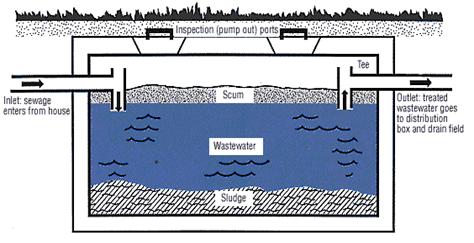Caring for your Septic System: A Reference Guide for Homeowners
Caring for Your Septic System (Conventional Septic System, Innovative/Alternative (I/A) System, or Cesspool)
The accumulated solids in the bottom of the septic tank should be pumped out every three years to prolong the life of your system. Septic systems must be maintained regularly to stay working.
Neglect or abuse of your system can cause it to fail. Failing systems can
- cause a serious health threat to your family and neighbors,
- degrade the environment, especially lakes, streams and groundwater,
- reduce the value of your property,
- be very expensive to repair,
- and, put thousand of water supply users at risk if you live in a public water supply watershed and fail to maintain your system.
Be alert to these warning signs of a failing system:
- sewage surfacing over the drainfield (especially after storms),
- sewage back-ups in the house,
- lush, green growth over the drainfield,
- slow draining toilets or drains,
- sewage odors
 Tips to Avoid Trouble
Tips to Avoid Trouble
- DO have your tank pumped out and system inspected every 3 to 5 years by a licensed septic contractor (listed in the yellow pages).
- DO keep a record of pumping, inspections, and other maintenance. Use the back page of this brochure to record maintenance dates.
- DO practice water conservation. Repair dripping faucets and leaking toilets, run washing machines and dishwashers only when full, avoid long showers, and use water-saving features in faucets, shower heads and toilets.
- DO learn the location of your septic system and drainfield. Keep a sketch of it handy for service visits. If your system has a flow diversion valve, learn its location, and turn it once a year. Flow diverters can add many years to the life of your system.
- DO divert roof drains and surface water from driveways and hillsides away from the septic system. Keep sump pumps and house footing drains away from the septic system as well.
- DO take leftover hazardous household chemicals to your approved hazardous waste collection center for disposal. Use bleach, disinfectants, and drain and toilet bowl cleaners sparingly and in accordance with product labels.
- DON'T allow anyone to drive or park over any part of the system. The area over the drainfield should be left undisturbed with only a mowed grass cover. Roots from nearby trees or shrubs may clog and damage your drain lines.
- DON'T make or allow repairs to your septic system without obtaining the required health department permit. Use professional licensed contractors when needed.
- DON'T use commercial septic tank additives. These products usually do not help and some may hurt your system in the long run.
- DON'T use your toilet as a trash can by dumping nondegradables down your toilet or drains. Also, don't poison your septic system and the groundwater by pouring harmful chemicals down the drain. They can kill the beneficial bacteria that treat your wastewater. Keep the following materials out of your system:
Nondegradables
grease, disposable diapers, plastics, etc.
Poisons
gasoline, oil, paint, paint thinner, pesticides, antifreeze, etc.
Septic System Explained
Septic systems are individual wastewater treatment systems (conventional septic systems, innovative/alternative (I/A) systems, or cesspools) that use the soil to treat small wastewater flows, usually from individual homes. They are typically used in rural or large lot settings where centralized wastewater treatment is impractical.
There are many types of septic systems in use today. While all systems are individually designed for each site, most systems are based on the same principles. A Conventional Septic System
A Conventional Septic System
A conventional septic system consists of a septic tank, a distribution box and a drainfield, all connected by pipes, called conveyance lines.
Your septic system treats your household wastewater by temporarily holding it in the septic tank where heavy solids and lighter scum are allowed to separate from the wastewater. This separation process is known as primary treatment. The solids stored in the tank are decomposed by bacteria and later removed, along with the lighter scum, by a professional septic tank pumper.
After partially treated wastewater leaves the tank, it flows into a distribution box, which separates this flow evenly into a network of drainfield trenches. Drainage holes at the bottom of each line allow the wastewater to drain into gravel trenches for temporary storage. This effluent then slowly seeps into the subsurface soil where it is further treated and purified (secondary treatment). A properly functioning septic system does not pollute the groundwater.
For More Information
A videotape version of this brochure, also entitled "Your Septic System: A Guide for Homeowners," is available through the EPA Small Flows Clearinghouse. Call 1-800-624-8301.
For more information about maintenance or inspection of your septic system, contact your local board of health.

